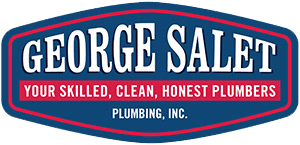
Buying an older home can feel like stepping into a storybook, at least, until you discover the pipes tell a different tale. Plumbing systems in historic or mid-century homes often hide years of wear beneath charming walls and tile. That’s why a plumbing inspection before buying a house isn’t just smart, it’s essential.
Older homes come with character and craftsmanship, but also unique maintenance challenges. From corroded pipes to outdated fixtures, it’s easy for small issues to turn into major repairs after closing. This guide walks you through the plumbing checklist for older homes so you know exactly what to look for and when to call the team at George Salet Plumbing.
At a Glance
- Inspect visible pipes for corrosion or leaks.
- Check water pressure and drainage speed in every room.
- Ask about the home’s sewer line history.
- Identify outdated materials like galvanized or lead pipes.
- Hire a licensed plumber for a full inspection before finalizing the sale.
Pipe Materials Tell a Story
The plumbing in older homes often reveals its age through the materials used. Over time, building codes and safety standards have changed, but many older homes still rely on the same original piping.
Those systems may have held up for decades, but they weren’t made for the water pressure, appliances, and health regulations of modern living. Understanding what kind of pipes you’re dealing with can make the difference between a small weekend project and a major renovation.
Common outdated materials include:
- Galvanized steel: These pipes were once the gold standard in durability, but decades of exposure cause the interior to rust and corrode. As the walls of the pipe close in with buildup, water flow slows to a trickle and can carry a reddish tint. Eventually, leaks form where the corrosion eats through the metal.
- Lead: Used in older plumbing for its flexibility, lead pipes pose serious health risks when it leaches into drinking water. Even low levels of exposure are unsafe, especially for children and pregnant individuals. Any home still using lead lines should have them replaced immediately.
- Polybutylene: A popular choice during the late 20th century for its low cost, this gray plastic piping hasn’t aged well. Over time, it becomes brittle and prone to cracking, often without visible warning. Failures tend to happen suddenly, leading to major leaks and costly damage.
Spotting these materials early allows you to budget for upgrades before disaster strikes. A professional inspection can map out your plumbing network, identify potential weak spots, and estimate how long your current system is likely to hold up.
In older homes, that knowledge is invaluable, as what you can’t see can hurt your investment later.
Test Water Pressure and Flow
Turn on every faucet, shower, and outdoor spigot to get a feel for how the water moves through the house. Steady, consistent pressure is a good sign. If it sputters, slows, or takes a moment to build up, that’s a red flag for hidden plumbing issues. Problems can range from mineral buildup inside old pipes to partial clogs or even small leaks hidden behind the walls.
Don’t forget to check both hot and cold taps. Uneven pressure between them can reveal corrosion or sediment trapped in specific lines. Older homes are especially prone to this, since the pipes may have narrowed over decades of use.
Pro Tip: Run multiple fixtures at once. If pressure drops drastically, your plumbing may be clogged or undersized for modern use.
Examine Drains and Sewer Lines
Slow drains often signal more than a minor clog. In older Bay Area homes, tree roots frequently infiltrate clay sewer lines, leading to backups and costly repairs.
Ask your inspector to perform a video sewer line inspection to reveal cracks, obstructions, or pipe collapses before you sign the closing papers. It’s one of the most valuable steps in any home plumbing inspection.
Look for Leaks and Water Damage
Check under sinks, behind toilets, and around your water heater. Even small leaks can waste gallons of water and cause structural damage. Discoloration on ceilings, warped baseboards, or musty smells are red flags for long-term moisture problems.
Pro Tip: Bring a flashlight to inspect basement pipes and crawl spaces as this is often where leaks love to hide.
Don’t Forget the Water Heater
Older homes often come with older water heaters, and that’s not a good thing. Check the unit’s age (you’ll find the serial number on the label) and look for rust, leaks, or rumbling sounds.
A tank older than 10 years should be replaced to avoid sudden failure or flooding. Routine plumbing inspections from George Salet Plumbing include a full water heater check for safety and performance.
Verify Fixtures, Valves, and Shut-Offs
Make sure all fixtures are working properly and that every water line has an accessible shut-off valve. Corroded valves or stiff handles can prevent you from stopping leaks quickly, turning a small drip into major damage.
Pro Tip: If your main water shut-off is hard to turn or corroded, replace it right away, especially before moving in.
Don’t Let Old Pipes Drain Your Wallet
A charming vintage home shouldn’t come with hidden plumbing nightmares. Following this plumbing checklist for older homes helps you identify risks early, negotiate repairs with confidence, and move in worry-free.
Professional insight is priceless, especially with plumbing issues in old homes. Before closing day, book a detailed home plumbing inspection to uncover what’s behind those walls and under the floors.
Schedule Expert Plumbing Help in San Francisco
Buying a home built before 1980? Schedule a full inspection with George Salet Plumbing to make sure your system is safe and sound. Our experienced Bay Area plumbers catch small leaks and hidden problems before they turn costly.
Call (415) 234-0733 or contact our expert team online to schedule your inspection today.
